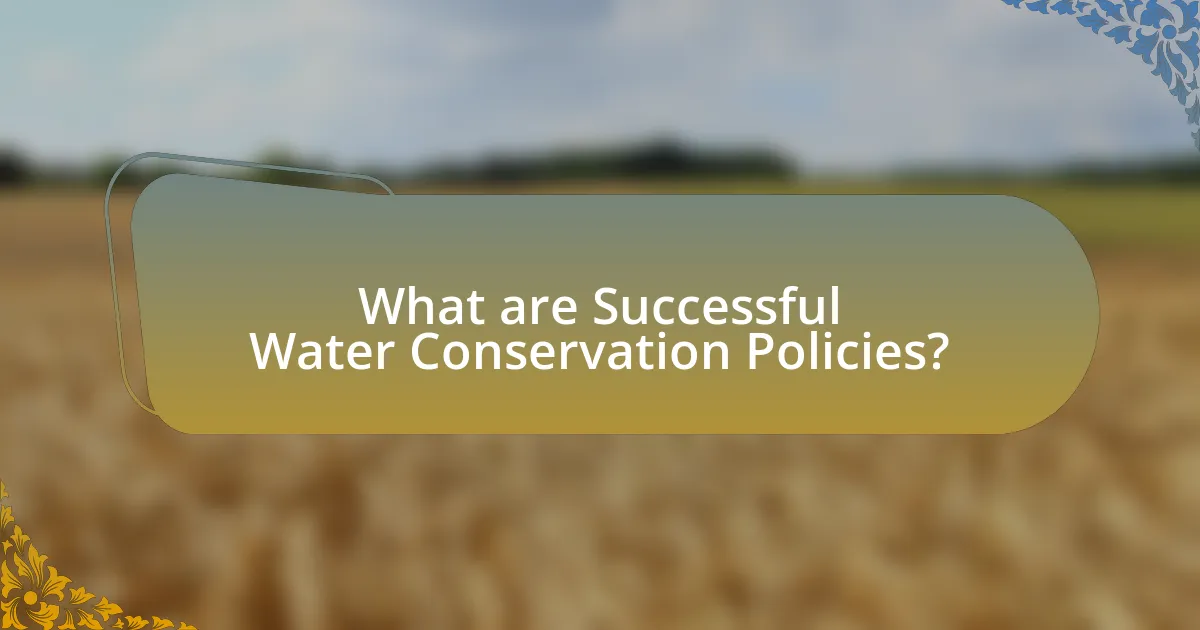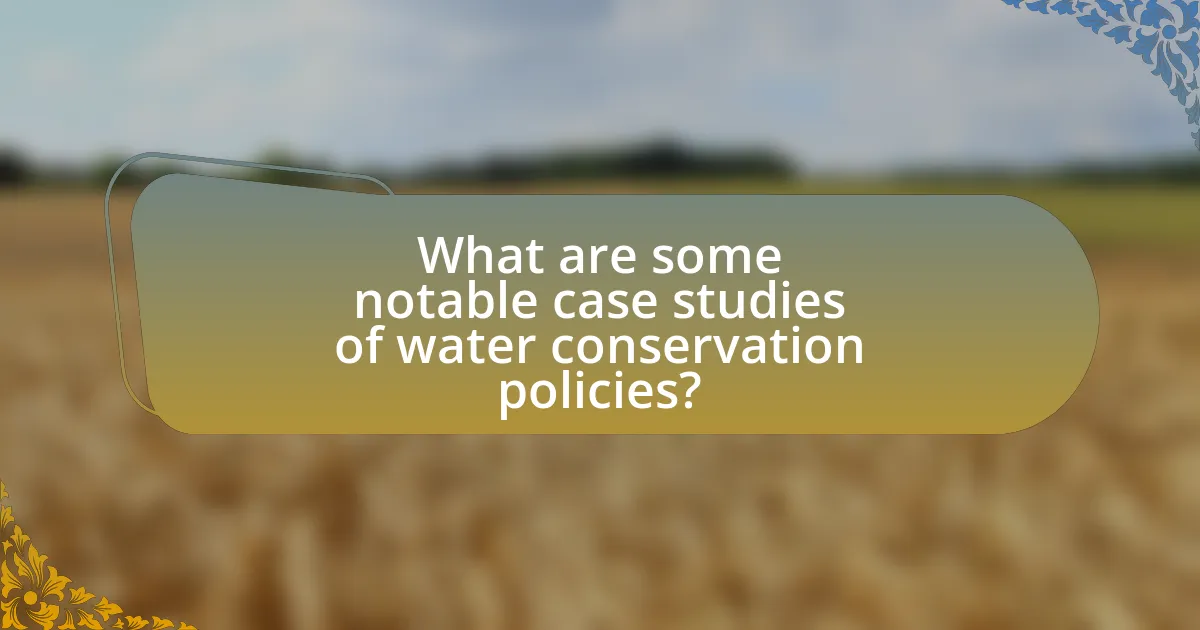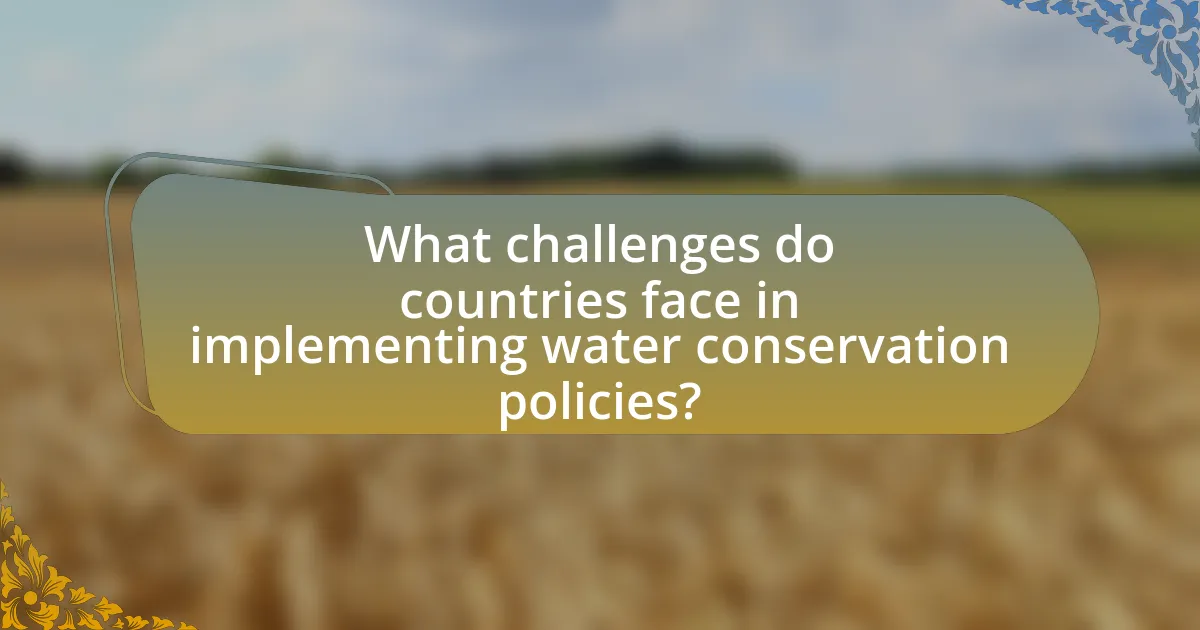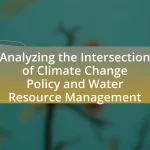The article focuses on case studies of successful water conservation policies implemented globally, highlighting effective strategies that promote efficient water use, reduce consumption, and enhance public awareness. It examines notable examples from California, Australia, Israel, and Cape Town, showcasing how regulatory frameworks, economic incentives, and community engagement contribute to significant reductions in water usage. The article also discusses the impact of cultural and geographical factors on policy effectiveness, the importance of studying successful initiatives for sustainable development, and the challenges faced in implementing these policies. Key indicators of success, best practices, and lessons learned from various case studies are also outlined, providing a comprehensive overview of effective water conservation strategies worldwide.

What are Successful Water Conservation Policies?
Successful water conservation policies include regulations that promote efficient water use, incentives for reducing consumption, and public education campaigns. For instance, California’s water conservation measures, implemented during severe droughts, mandated reductions in water use by 25% across urban areas, leading to a significant decrease in overall water consumption. Additionally, Australia’s water management strategies, particularly the Water Smart Australia initiative, have successfully integrated technology and community engagement to enhance water efficiency, resulting in a 30% reduction in urban water use since its inception. These examples demonstrate that effective policies combine regulatory frameworks, economic incentives, and community involvement to achieve substantial water savings.
How do these policies impact water usage globally?
Water conservation policies significantly reduce global water usage by promoting efficient practices and technologies. For instance, countries implementing strict regulations on agricultural water use have reported reductions in water consumption by up to 30%, as seen in Israel’s drip irrigation systems. Additionally, urban areas adopting water-saving fixtures and rainwater harvesting have decreased per capita water use by 20% or more, as evidenced by policies in cities like Singapore. These measures collectively contribute to a more sustainable global water supply, addressing the increasing demand and scarcity issues faced worldwide.
What are the key components of effective water conservation policies?
Effective water conservation policies include regulatory frameworks, public education, financial incentives, and technological innovation. Regulatory frameworks establish legal standards for water use and conservation, ensuring compliance and accountability among users. Public education campaigns raise awareness about the importance of water conservation, promoting behavioral changes that lead to reduced consumption. Financial incentives, such as subsidies for water-efficient appliances or tax breaks for conservation efforts, encourage individuals and businesses to adopt sustainable practices. Technological innovation, including advanced irrigation systems and water recycling methods, enhances efficiency and reduces waste. These components collectively contribute to the success of water conservation initiatives, as evidenced by programs in countries like Israel, which has implemented comprehensive policies resulting in significant water savings and sustainable management practices.
How do cultural and geographical factors influence these policies?
Cultural and geographical factors significantly influence water conservation policies by shaping community values, resource availability, and environmental conditions. For instance, in arid regions like the Middle East, cultural practices emphasize water conservation due to the scarcity of water resources, leading to policies that promote efficient irrigation techniques and rainwater harvesting. Conversely, in regions with abundant rainfall, such as parts of Southeast Asia, cultural attitudes may prioritize different aspects of water management, resulting in policies focused on flood control and water quality rather than conservation. Additionally, geographical factors, such as topography and climate, dictate the types of water conservation methods that are feasible, as seen in the implementation of terracing in hilly areas to prevent soil erosion and maximize water retention. These examples illustrate how cultural beliefs and geographical characteristics directly inform the development and success of water conservation policies worldwide.
Why is it important to study successful water conservation policies?
Studying successful water conservation policies is crucial because it enables the identification of effective strategies that can be replicated in different contexts. Successful policies often lead to significant reductions in water usage, improved water quality, and enhanced ecosystem health. For instance, the implementation of water-saving technologies in Israel has resulted in a 50% reduction in water consumption for agriculture, demonstrating the effectiveness of innovative practices. By analyzing these successful cases, policymakers can adopt best practices, tailor solutions to local needs, and ultimately contribute to sustainable water management globally.
What lessons can be learned from these case studies?
The lessons learned from case studies of successful water conservation policies around the world include the importance of community engagement, the effectiveness of regulatory frameworks, and the benefits of integrating technology. Community engagement fosters local ownership and compliance, as seen in Australia’s water management strategies, which involved stakeholders in decision-making processes. Regulatory frameworks, such as those implemented in Singapore, demonstrate that strong policies can lead to significant reductions in water usage through mandatory conservation measures. Additionally, the integration of technology, exemplified by Israel’s advanced irrigation systems, shows that innovative solutions can enhance water efficiency and sustainability. These case studies collectively highlight that a multifaceted approach combining community involvement, regulation, and technology is essential for effective water conservation.
How do these policies contribute to sustainable development?
Water conservation policies contribute to sustainable development by ensuring the efficient use and management of water resources, which is essential for environmental sustainability, economic growth, and social equity. These policies promote practices such as rainwater harvesting, wastewater recycling, and efficient irrigation techniques, which reduce water waste and enhance water availability. For instance, the implementation of water-saving technologies in agriculture can lead to a 30% reduction in water use while maintaining crop yields, thereby supporting food security and reducing the ecological footprint. Additionally, successful water conservation policies can improve community resilience to climate change impacts, as seen in countries like Israel, where integrated water resource management has led to a significant increase in water supply despite arid conditions.

What are some notable case studies of water conservation policies?
Notable case studies of water conservation policies include the city of Cape Town, South Africa, which implemented a comprehensive water management strategy during its severe drought in 2017, reducing water consumption by 50% through public awareness campaigns and strict water usage regulations. Another example is the state of California, USA, which enacted the Sustainable Groundwater Management Act in 2014, leading to improved groundwater management practices and a reported 20% reduction in water use during the 2012-2016 drought period. Additionally, Israel’s National Water Carrier project and its extensive use of desalination and wastewater recycling have resulted in a 90% water reuse rate, showcasing effective long-term water conservation strategies.
How did Australia implement its water conservation strategies?
Australia implemented its water conservation strategies through a combination of regulatory measures, public awareness campaigns, and technological innovations. The government established the National Water Initiative in 2004, which aimed to improve water management across the country by promoting sustainable practices and enhancing water efficiency. Additionally, various states introduced water restrictions during drought periods, which included limitations on outdoor water use and incentives for water-saving appliances. The implementation of advanced irrigation techniques and the use of recycled water in agriculture further supported these strategies. Evidence of success can be seen in the reduction of urban water consumption by approximately 30% since the early 2000s, demonstrating the effectiveness of these comprehensive measures.
What specific measures were taken during the Millennium Drought?
During the Millennium Drought, which lasted from 1997 to 2009 in Australia, specific measures included the implementation of water restrictions, investment in desalination plants, and the promotion of water-saving technologies. Water restrictions limited outdoor water use, such as watering gardens and washing cars, effectively reducing urban water consumption by up to 50% in some areas. The construction of desalination plants, such as the one in Sydney, provided an alternative water source, producing potable water from seawater. Additionally, the government encouraged the adoption of water-efficient appliances and rainwater harvesting systems, which contributed to a significant decrease in overall water usage. These measures collectively aimed to enhance water security and sustainability during a prolonged period of drought.
What were the outcomes of these measures on water usage?
The outcomes of these measures on water usage included significant reductions in consumption and improved efficiency in water management. For instance, cities implementing water conservation policies, such as tiered pricing and public awareness campaigns, reported decreases in water usage by up to 30%. Additionally, regions that adopted rainwater harvesting and greywater recycling systems experienced a reduction in demand on municipal water supplies, leading to more sustainable water practices. These results demonstrate the effectiveness of targeted conservation measures in achieving lower water usage and promoting responsible water management.
What strategies were employed in Israel for water conservation?
Israel employed several effective strategies for water conservation, including advanced irrigation techniques, wastewater recycling, and public awareness campaigns. The country is a leader in drip irrigation technology, which allows for precise water application directly to plant roots, significantly reducing water waste. Additionally, Israel recycles approximately 90% of its wastewater for agricultural use, making it the highest percentage globally. Public awareness campaigns have also played a crucial role in promoting water-saving practices among citizens, leading to a cultural shift towards conservation. These strategies collectively contribute to Israel’s ability to manage its limited water resources effectively.
How has technology played a role in Israel’s water management?
Technology has significantly enhanced Israel’s water management through advanced irrigation systems, desalination processes, and water recycling techniques. The country employs drip irrigation, which delivers water directly to plant roots, increasing efficiency and reducing waste; this method has been adopted widely, leading to a 50% reduction in water usage for agriculture. Additionally, Israel has developed cutting-edge desalination plants, such as the Sorek facility, which produces approximately 20% of the nation’s drinking water, making it a leader in converting seawater into potable water. Furthermore, Israel recycles around 90% of its wastewater for agricultural use, the highest rate globally, showcasing the effective integration of technology in sustainable water practices.
What can other countries learn from Israel’s approach?
Other countries can learn the importance of innovative technology and efficient water management practices from Israel’s approach to water conservation. Israel has implemented advanced irrigation techniques, such as drip irrigation, which significantly reduces water waste by delivering water directly to the plant roots. This method has been shown to increase agricultural productivity while using less water, with studies indicating that drip irrigation can save up to 50% more water compared to traditional methods. Additionally, Israel’s investment in desalination technology has enabled the country to convert seawater into potable water, providing a sustainable water source that other nations facing water scarcity could replicate. These strategies highlight the effectiveness of combining technology with policy to address water conservation challenges.

What challenges do countries face in implementing water conservation policies?
Countries face significant challenges in implementing water conservation policies, primarily due to economic constraints, political will, and public awareness. Economic constraints often limit funding for infrastructure improvements and technology necessary for effective water management. Political will can be hindered by competing interests, such as agricultural demands and industrial growth, which may prioritize short-term gains over sustainable practices. Additionally, public awareness and engagement are crucial; without understanding the importance of water conservation, communities may resist changes or fail to adopt new practices. For instance, a study by the World Bank highlights that countries with strong public engagement in water management see higher compliance and better outcomes in conservation efforts.
How do economic factors affect the success of these policies?
Economic factors significantly influence the success of water conservation policies by determining funding availability, resource allocation, and public willingness to adopt conservation measures. For instance, regions with strong economic growth can invest in advanced technologies and infrastructure that enhance water efficiency, as seen in Singapore’s investment in desalination and water recycling, which has led to a 50% reduction in water consumption per capita since the 1990s. Conversely, areas facing economic downturns may struggle to implement or sustain such policies due to budget constraints, leading to inadequate infrastructure and lower public engagement. Additionally, economic incentives, such as subsidies for water-saving appliances or tiered pricing structures, can motivate individuals and businesses to adopt conservation practices, as demonstrated in California, where financial incentives have resulted in a 20% reduction in urban water use during drought periods.
What role does government support play in policy implementation?
Government support is crucial in policy implementation as it provides the necessary resources, authority, and legitimacy to enforce policies effectively. For instance, in successful water conservation initiatives, government backing often includes funding, regulatory frameworks, and public awareness campaigns that facilitate compliance and participation among stakeholders. A notable example is the California State Water Resources Control Board, which implemented strict water conservation regulations during drought periods, supported by state funding for water-saving technologies and public education efforts. This comprehensive support structure enhances the likelihood of successful policy outcomes by ensuring that all necessary components are in place for effective implementation.
How can public awareness and education improve policy effectiveness?
Public awareness and education can significantly improve policy effectiveness by fostering informed citizen engagement and compliance. When the public understands the importance of water conservation policies, they are more likely to support and adhere to these initiatives. For instance, studies have shown that communities with educational programs on water conservation, such as those implemented in Australia, experienced a 20% reduction in water usage during drought periods. This demonstrates that informed citizens can actively contribute to the success of policies aimed at sustainable water management.
What are the common pitfalls in water conservation policy implementation?
Common pitfalls in water conservation policy implementation include inadequate stakeholder engagement, lack of clear objectives, insufficient funding, and poor data management. Inadequate stakeholder engagement often leads to resistance from communities, as policies may not reflect local needs or priorities. Lack of clear objectives can result in ambiguous goals, making it difficult to measure success or progress. Insufficient funding restricts the ability to execute programs effectively, while poor data management hampers the ability to monitor water usage and assess the impact of conservation efforts. These issues have been documented in various case studies, highlighting the importance of comprehensive planning and community involvement in successful water conservation initiatives.
How can these pitfalls be avoided in future policies?
To avoid pitfalls in future water conservation policies, policymakers should implement comprehensive stakeholder engagement processes. Engaging local communities, experts, and relevant organizations ensures that diverse perspectives are considered, leading to more effective and inclusive policies. For instance, the success of the Cape Town water crisis response was largely attributed to active public participation and transparent communication, which fostered community buy-in and compliance with water-saving measures. Additionally, integrating adaptive management practices allows for ongoing assessment and adjustment of policies based on real-time data and feedback, as demonstrated by successful initiatives in Israel, where continuous monitoring has led to improved water efficiency.
What role does stakeholder engagement play in successful implementation?
Stakeholder engagement is crucial for the successful implementation of water conservation policies as it fosters collaboration, builds trust, and ensures that diverse perspectives are considered. Engaging stakeholders, such as local communities, government agencies, and environmental organizations, leads to more effective decision-making and enhances the legitimacy of the policies. For instance, the success of the “Water Sensitive Urban Design” initiative in Australia demonstrated that involving stakeholders in the planning process resulted in higher acceptance and better outcomes, as stakeholders contributed valuable insights and local knowledge. This collaborative approach not only improves policy effectiveness but also encourages shared responsibility for water conservation efforts.
What best practices can be derived from successful case studies?
Best practices derived from successful case studies in water conservation policies include community engagement, data-driven decision-making, and adaptive management. Community engagement fosters local ownership and participation, as seen in Australia’s water-saving initiatives, where public involvement led to significant reductions in water usage. Data-driven decision-making is exemplified by Israel’s use of advanced technologies for monitoring water resources, resulting in efficient water allocation and management. Adaptive management, demonstrated in California’s response to drought conditions, allows for flexible policy adjustments based on real-time data and changing environmental conditions, enhancing resilience and effectiveness in water conservation efforts.
How can these practices be adapted to different regions?
Water conservation practices can be adapted to different regions by considering local climate, culture, and water availability. For instance, in arid regions, implementing rainwater harvesting systems can effectively capture and store scarce rainfall, as demonstrated in countries like Israel, where such systems have significantly increased water supply. In contrast, regions with abundant rainfall may focus on improving infrastructure for stormwater management to prevent flooding and enhance groundwater recharge, as seen in cities like Singapore. Tailoring these practices to regional specifics ensures their effectiveness and sustainability, supported by successful case studies worldwide.
What are the key indicators of success in water conservation policies?
Key indicators of success in water conservation policies include measurable reductions in water consumption, improved water quality, and increased public awareness and engagement. For instance, cities implementing effective water conservation measures, such as San Diego, have reported a 20% reduction in per capita water use since 2007, demonstrating the effectiveness of targeted policies. Additionally, successful policies often lead to enhanced ecosystem health, as seen in the restoration of wetlands in the Everglades, which improved water quality and biodiversity. Public engagement metrics, such as participation rates in conservation programs, also serve as indicators; for example, a 2019 survey indicated that 75% of residents in water-scarce regions actively participated in conservation efforts, reflecting the success of educational campaigns.


